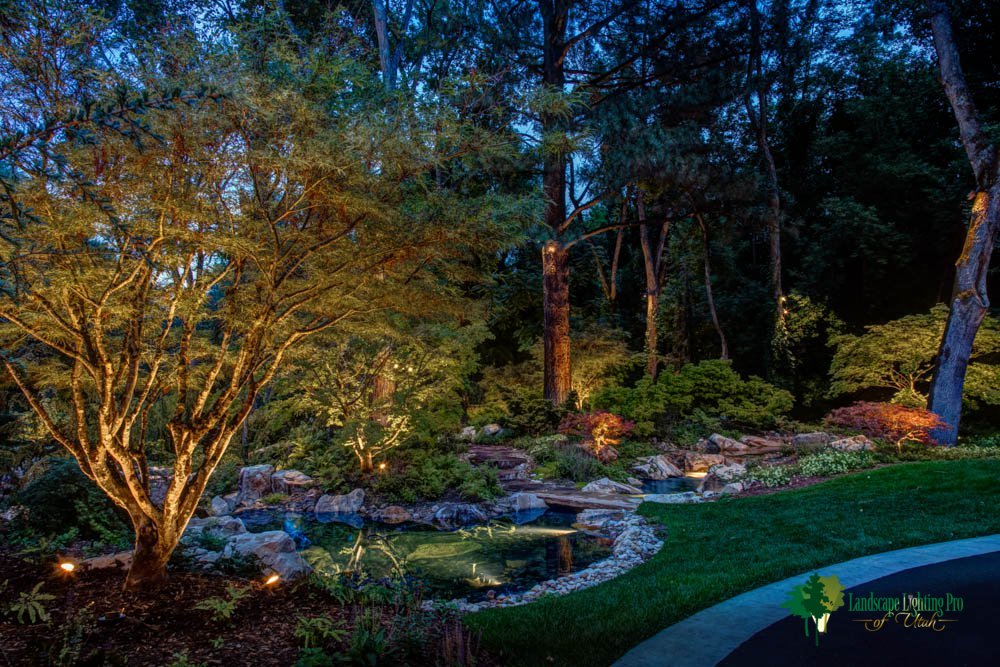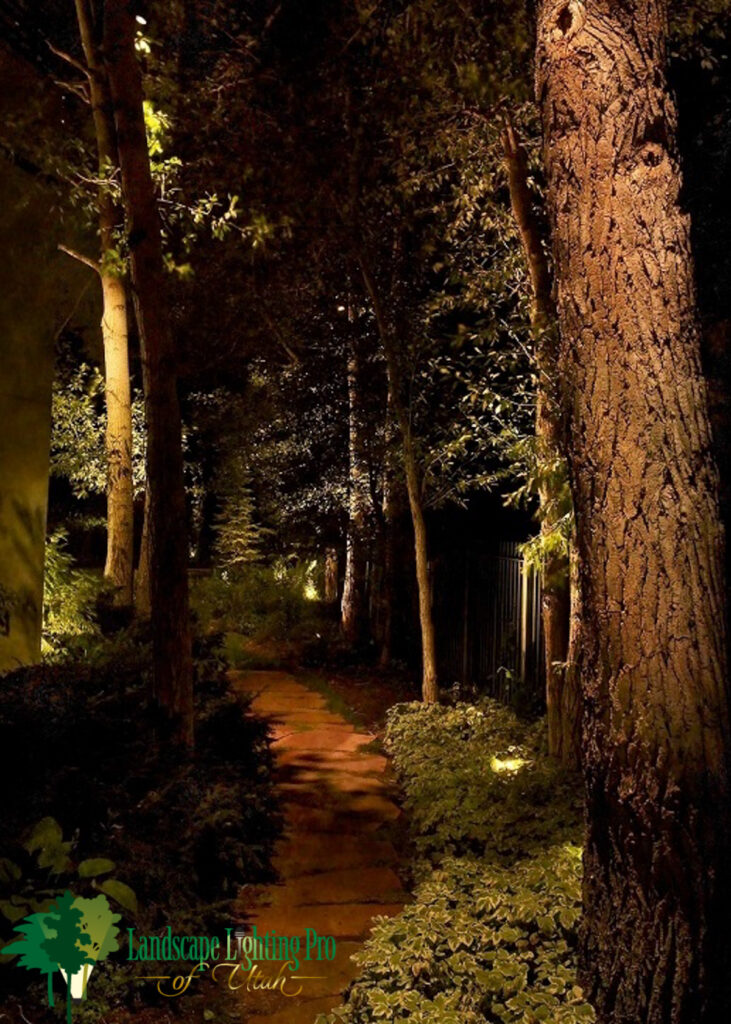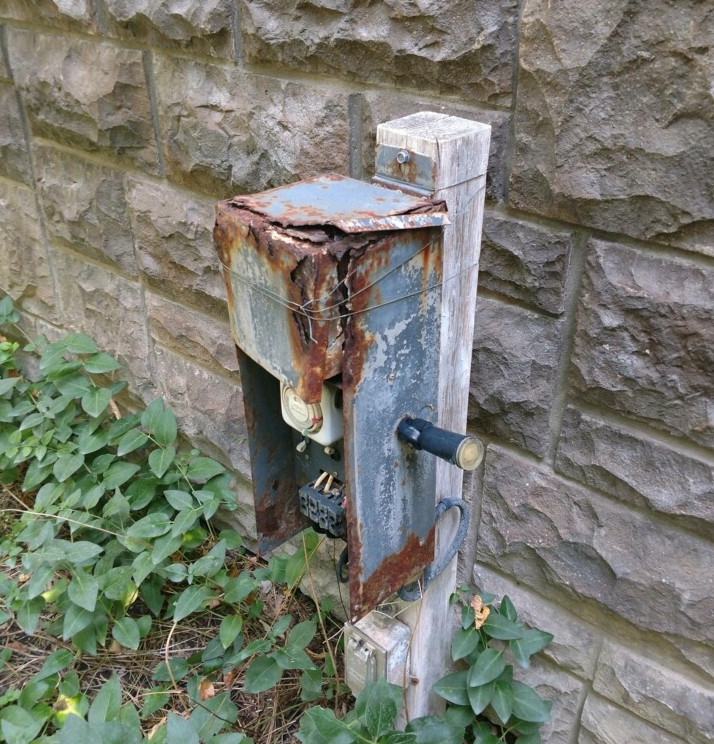5 Common Landscape Lighting Mistakes and How to Avoid [Download Free Lighting Design Guide]
5 Common Landscape Lighting Mistakes
Are you fairly new to outdoor lighting? There are common landscape lighting mistakes people make when they first get started. Learning how to avoid these these 5 common landscape lighting mistakes will make sure your outdoor lighting system is beautiful, will continually perform well, and bring you years of enjoyment.
1. Focusing Too Much On the Engineering
When people start researching and learning about doing landscape lighting for their property, they get excited to learn the technical aspects of how low voltage landscape lighting systems operate. Now, don’t get me wrong, It is important to have a full understanding of your lighting system. The technical piece is very important. However, a technically sound system isn’t worth a whole lot if the lighting design is poorly thought out.

Whether you are working with a professional lighting designer or not, save the technical stuff for later. First, figure out what you want to have lit and why. Figuring out the design first is the key to fashioning a beautiful lighting system later.
Before you begin worrying over wire runs and load drops, figure out the design for the lights first! But remember, the engineering is also important, so make sure everything is done technically sound.
2. Design With Light, Not Fixtures
There are lots of cool fixtures out there. It can be a lot of fun to try and figure out neat ways these fixtures can be used to create different lighting effects. However, make sure you are designing with light and not fixtures.
‘Design with light and not fixtures’ simply means to think about where you want to have light, then decide after that which fixture will best enable you to create that affect. The light source, the light bulb inside the fixture, is what actually does all the work. The fixture is simply there as a vessel to house the bulb. Figure out what you want to see and experience at night, then decide on the best method to make that vision reality.
We’ve seen many times where the wrong fixture was used for the wrong job. The wrong fixture is used when the fixture is selected for reasons other than the job that fixture is intended for.

For Example, if someone is in love with the look of a particular path light, they might try to incorporate that path light into areas of their property where it really doesn’t make sense to have a path light. A flowerbed in the corner of a backyard is a strange place to install a path light when there is no path in need of light.
Focus on the light, not the fixture.
3. Poor Fixture Material Selection
Pay attention to the materials a fixture is made from and how well it has been engineered/constructed. If a fixture isn’t going to stand up and continue to work for the years to come, why bother?
Landscape lighting fixtures can be built from a number of different materials. The most common materials used are Aluminum, Stainless Steel, Copper, and Brass.
This is a lot of information, but I’ll try and keep it simple. There are two kinds of metals used in the construction of landscape fixtures: ferrous and non ferrous metals.
Ferrous metals are considered reactive metals, they will corrode and become damaged over time. Ferrous metals include aluminum. While it makes sense that cast aluminum is used so often for building landscape fixtures, it isn’t a quality material.
There is a way aluminum can be treated to improve its durability. However, this increases the fixture’s price and doesn’t permanently cure aluminum from corrosion, it just prolongs it.

Non-ferrous metals are considered non-reactive metals and are resistant to corrosion.
Non-ferrous metals include stainless steel, copper, and brass. These metals are great materials used in fixtures built to last a life time.
The quality of the construction is where the real factor comes in when you are looking at copper or brass fixtures.
Avoid fixtures built from aluminum and completely ignore fixtures built from composite materials. Aluminum will corrode and composite (Plastic) will warp, crack, become brittle, and otherwise completely fail.
4. Not Budgeting Enough
No one said it better than Benjamin Franklin: “The Bitterness of Poor Quality Remains Long After the Sweetness of Low Price is Forgotten”.
Not having a realistic budget is a common mistake. Many have had the unfortunate experience of having the landscape lighting system their landscape contractor installed fail a year or two after installation. The blame doesn’t necessarily lie with the contractor, it lies with misinformation about low voltage lighting systems and the true difference quality provides.
A quality lighting system tends to come in at a higher price point, so its important to budget accordingly. There are three key elements to a quality landscape lighting system: beautiful design, high end materials, and quality engineering.
- Design
If the design, what we see and experience at night, isn’t beautiful and inspiring, then why bother? Beautiful lighting is not worth sacrificing for a low price. Companies that specialize in landscape lighting, contractors whose only focus is outdoor illumination, will be able to provide a beautiful lighting design tailored around your home and your needs. Here, check out our free lighting design guide to get you started with your own lighting design (See Bottom of Page).
- Materials
There are a lot of landscape lighting products on the market. Only a handful of manufacturers build a brass/copper fixture that will truly last. These high quality brass/copper fixtures come at a slightly higher price point.
Copper and brass fixtures built from a thicker metal cost more then the tinfoil thin versions. Don’t compromise on quality. If you aren’t convinced that a fixture will stand up in your landscape, look to one that will. Remember, settling for less won’t pay you back any favors in the long run.
- Engineering
The way a lighting system is crafted and built will have a direct impact on the system’s durability. Thicker gauge wires with water proof connections (not grease filled wire nuts) and outdoor rated LED bulbs will make for a robust lighting system. Take a look at the below photo.

This is a great example of why quality engineering and materials matter. The photo of this painted steel transformer was taken 5 years after it was installed. The problem with it (aside from the immediate blaring issues) is that it was installed to reduce the price of the system. Its built cheaply, and thus failed. if a stainless steel transformer had been used here it wouldn’t have corroded and ultimately failed.
5. Looking after your Lighting System
One of the biggest mistakes people make with their landscape lighting system is not looking after it. Even the best engineered and designed lighting systems, built from the finest materials, will likely fail if there isn’t a certain amount of upkeep.
The outdoor environment is a brutal place. Between ice and freezing temperatures in the winter and blistering hot summers, your system goes through a lot of heat fluctuation. Rain, dust, insect/animal activity, growing plants, etc., all take their toil.
Servicing your system once a year is all it takes to make sure your lighting system is working as efficiently as the day it was installed. What does servicing a lighting system involve?
- Remove hard water deposits from all fixture lenses.
- Bury any exposed wire.
- Trim back plant material (overgrown ornamental grasses/shrubs, tree root suckers, etc.) to make sure fixtures can aim their light’s beam without being interrupted.
- Move location of fixtures to accommodate plant growth (move fixture further from a tree that has experienced significant growth.
- Tighten and test terminal blocks inside transformers with a multi meter. Adjust power loads if needed.
- Check, adjust, and replace the timers inside your lighting control timer.
- Adjust, straighten, and re-aim fixtures that are crooked or not hitting their
target. - Check each individual light bulb: replace burned out bulbs (if any).
If you’d prefer to have an experienced landscape lighting technician perform an annual service on your system, professional landscape lighting companies often offer service plans. They can go through your whole lighting system with a fine tooth comb and you’ll have piece of mind knowing your lights are working at their very best.

Conclusion:
To get the most out of your landscape lighting, remember that the key to success is quality and forethought. Study your home and landscape to devise a thoughtful lighting design. Remember to design with light, not fixtures. Select non-ferrous fixtures that are robust and able to survive in the outdoor environment. Make sure you have a realistic budget; you only want to pay to have your lighting system installed once, right? And remember, looking after your lighting system and taking care of it will do more to ensure its longevity and continued success than anything else.
Landscape Lighting Makes All The Difference
At Landscape Lighting Pro of Utah, the art of outdoor illumination is a real passion we work to perfect. Designing elegantly bespoke landscape lighting systems is simply all we do. For over 15 years, our award winning team of designers and craftsmen have striven to bring the best outdoor lighting experience possible to people’s homes and businesses across the Wasatch Front and beyond.
Located in Midvale, Landscape Lighting Pro of Utah installs, maintains, and repairs lighting systems throughout Utah’s residential areas, including Salt Lake City, Park City, Draper, Davis, and Utah Counties.
If you have an upcoming project you’d like help with, call (801) 440-7647 for more information, schedule a free consultation, or feel free to simply fill out a contact form.
Salt Lake City (Midvale)
801-440-7647
St. George
435-932-6627
©2025 Landscape Lighting Pro
Privacy Policy
Cookie Policy